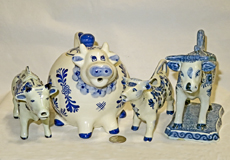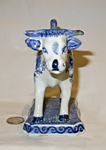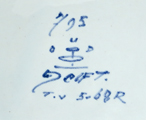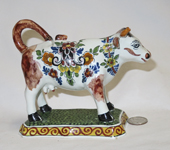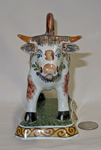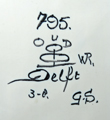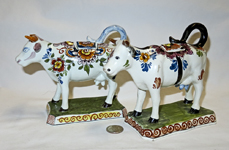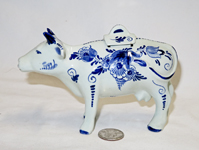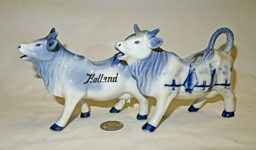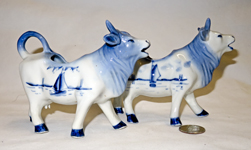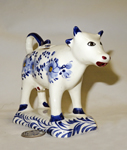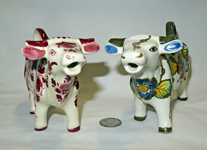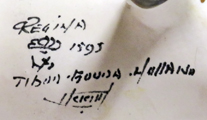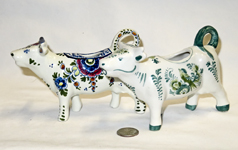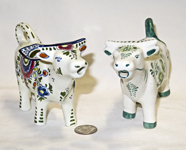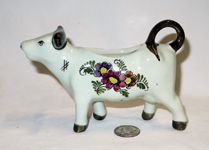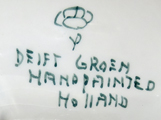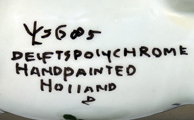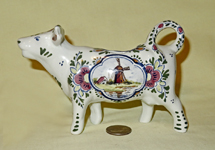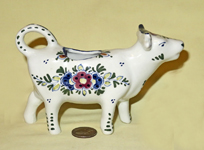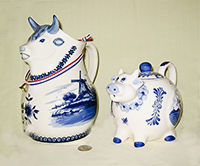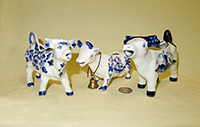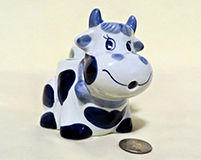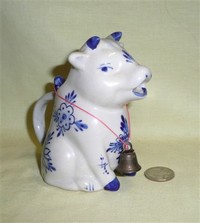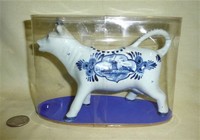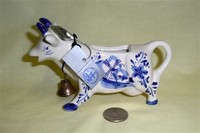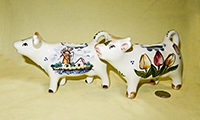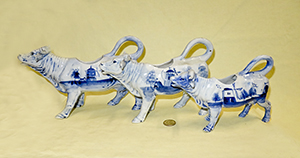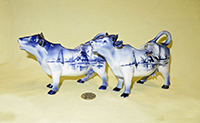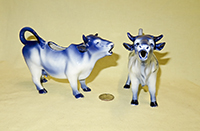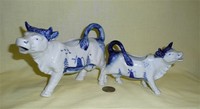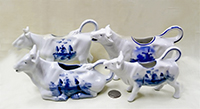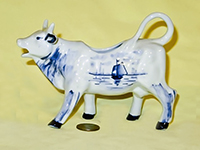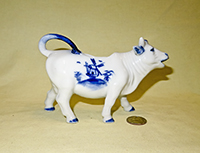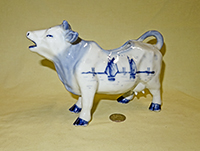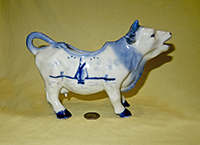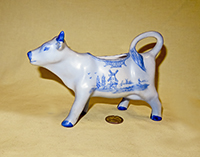
Delft
Wikipedia tells us that “Delft is a city and municipality in the province of South Holland, Netherlands. Delft is a popular tourist attraction, home to Delft University of Technology regarded as center of technological research and development in the Netherlands, Delft Blue pottery, and the currently reigning House of Orange-Nassau...Delftware or Delft pottery, also known as Delft Blue (Dutch: Delfts blauw), is a general term now used for Dutch tin-glazed earthenware, a form of faience. Most of it is blue and white pottery, and the city of Delft in the Netherlands was the major centre of production, but the term covers wares with other colours, and made elsewhere. It is also used for similar pottery that it influenced made in England, but this should be called English delftware to avoid confusion.”
From the website of De Delftse Pauw, http://www.delftsepauw.com/, we learn that :
“In the sixteenth century, in a number of Dutch towns, factories were established which among their items produced "Majolica". This "Majolica" was made with a tin-glaze and found its origins in Italy and Spain. The Dutch East Indian Company began importing porcelain from China in the seventeenth century. This porcelain, especially the blue and white became very popular. “The "Majolica" producing factories started at a certain moment to imitate this Chinese porcelain, because of several reasons. The imported Chinese porcelain meant competition. Civil war in China made that imports from China went down. Customers asked for specific items which due to distance took a long time to deliver and due to language problems the delivered item was not always what was ordered. In Delft, in the seventeenth century 32 factories were producing Delftware. One of them was a factory called "de Paauw". These factories were often established in beer breweries which had stopped their production. In the nineteenth century due to competition from other factories like Wedgewood in England and lack of innovations, the highlight of Delftware had come to a close. Nowadays in Delft only a few companies still produce the entirely handpainted traditional Delftware. One of these companies is "de Delftse Pauw". A company which is very loyal to this tradition.”
The Delft City website (www.delft.nl) features a number of factories that produce the famous pottery; for example the Royal Delft factory, Koninklijke Porceleyne Fles, dating from 1653, claims to be the only one that has remained operational in the city since the 17c. Their Royal Delft web site shows colorations that range from the traditional blue to polychrome, pinjacker (red, blue and gold decorations, based on Japanese Imari), and black.
My collection has a few older or at least reproduction traditional Delft Blue cow creamers. However most of the really great early Dutch pieces featuring cows are figurines not creamers, so as lovely as they are they haven’t made it to my collection. Although as noted on the ‘history’ page the Dutch were likely the first to fashion cow creamers, none that I am aware of were decorated in the ‘Delft’ style. On the other hand, that style or at least the coloration and decoration of Delft ware became so popular that it was widely adopted by potteries that were making cow creamers in the 19c and early 20c, so many of the fine pieces of what I am calling here ‘Delft’ were actually made in Germany or England. In addition, little cow creamers (as well as many other Delft pieces) make great souvenirs and tin-glazed earthenware is expensive so almost all of the ‘tourist type’ items, widely available in the city of Delft, are simply decorated in underglaze blue on a cheap white clay body. Even the term ‘Delft’ is no guarantee that a piece if from there, since the term isn’t copyrighted and as Wikipedia noted has come to mean the style more than the actual city. So in many cases despite the markings, the very recent ones come from Japan or China. Some with ’Delft’ like decorations and style are even souvenirs of other places – not least Holland, Michigan for example.
|
|
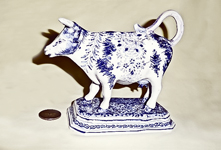
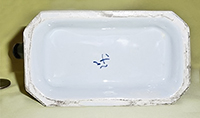
This is my one and only cow creamer that has, I believe, a legitimate claim to be early Delft Blauw - a lovely example from the late 19c. From what the seller said, the marks attribute this creamer to the Gebr. (brothers) Tichelaar factory, circa 1880-1895; currently named Tichelaars Koninklijke Makkumer Aardewerk-en Tegelfabriek (Royal Tichelaar Makkum). This supposedly was the first mark that they used. They have a neat website with an English version (start at http://www.tichelaar.nl/shop/ceramics.php) , from which I learned that “On a Spanish map from 1572, today’s location of Royal Tichelaar Makkum’s factory is already marked ‘bricaria’: a brickyard. It is the oldest proof of the company’s more than four centuries of uninterrupted ceramic history. By 1670, domestic pottery had replaced bricks as core business and from 1890 Royal Tichelaar Makkum concentrated on ornamental earthenware. The family company owes its continuity up to the present day to its appreciation of tradition, though with an eager eye for innovation.” They do have some cows on their web site shop, but none that are creamers…and given the current prices for the new ones, the amount I paid for this old beauty makes it a great bargain. |
|
|
|
|
|
|
|
|
|
|
|
|
Here’s a nice and unusual rendition that I believe to be quite modern, and is at any rate different from many of my other Delft creamers – assuming, that is, that it really is Delft since many with that moniker refer more to the style of decoration than the locale of manufacture. It’s hard to know for sure (although it was sold as vintage Delft), since its only markings are “15” and “F” written in blue, and it cane to me from exotic Arizona. The three flowers with yellow centers on each side are a nice touch, as are the bright red nostrils, small teats, and ‘lips’. Looks like it’s wearing lipstick. It is nicely made, with a small lid that bears the tip of the tail. |
|
|
|
|
|
|
|
|
|
|
My wife and I acquired the very large (10” tall) pitcher shown in the left photo above when we visited Delft in 1997. Some 5 years later I got the larger of the two pitchers shown here, which is from the same mold but with different decoration, and marked for the “Biltmore Estate Collection, Genuine Delft”. George Vanderbilt, grandson of Cornelius, visited Ashville NC in 1888, found it ideal for his ‘country home’, and built the 250 room Biltmore House (‘French Renaissance Chateau’) there between 1889 and 1895. These days the house and huge estate are a major tourist destination that in addition to just letting folks gawk at the grounds and house has a luxury hotel, inn, and cottage, and peddles wine, ‘professional development’ and equestrian activity…in addition to geegaws like this Delft cow. Its smaller neighbor (a mere 7 ½” tall) is a more recent acquisition, and is marked “Delft ©Deco, Handpainted Holland”, under a sketch of windmill, in an outline that looks to me sort of like a snowman. I do have another Delft-ish creamer similarly marked, so perhaps it really is from Holland. |
|
|
|
|
|
|
|
|
|
|
|
|
For the rest of this page, I will be featuring Delft ware cow creamers made elsewhere - most of them in Germany, and many of them from late 19c or early 20c. This lovely group of three large ones is a good place to start - they are porcelain, realistically molded, and adorned with pictures of an idyllic Dutch countryside - windmills, farm houses, birds and sailboats. They do not bear any maker's or national marks, but their style and quality imply that they came from one of the high end German porcelain factories, when quality cow creamers were popular. From the frequency in which they appear on ebay this form seems to have been extremely well liked. |
|
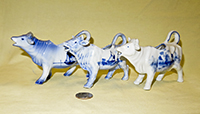 |
Here are three smaller German porcelain cow creamers, somewhat similar in style to the large ones above, with Delft coloration and decoration. In this case we know for sure they're from Germany because the bluish ones have it stamped on their belly, and the white one has it imprinted low on its left side. The one on the far left is a duplicate of my father's cow creamer from when he was a child, and that dates it to early 20c. |
|
|
|
|
|
|
|
|
|
|
|
|
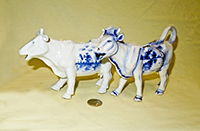 |
This pair appears to be from the same mold although the coloration, decorations and teats are quite different. Neither are marked, but both are likely from Germany.. |
|
 |
My, how tastes have changed over time. From the beautiful early 18c & 19 Delft cows to this - a caricature from the mid 2020s. Dutch craftsmen ought to be ashamed of themselves...but I guess if you want to make a living you have to produce for the masses. |
